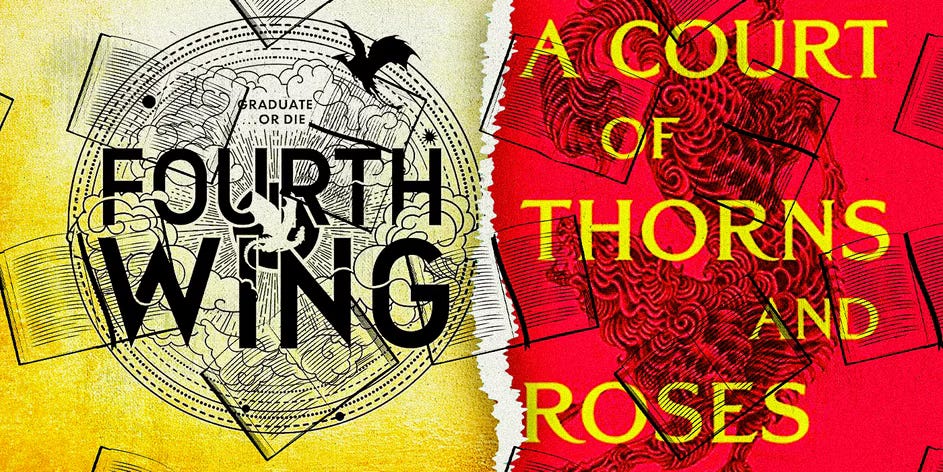On a recent flight home, I opened a friend’s copy of A Court of Thorns and Roses only to be tapped on the shoulder twice by the flight attendant: firstly to tell me how excited she was for me to enter the word of ACOTAR (as true fans call it) and later to let me know someone two rows up was reading the second book in the series if I wanted to discuss it further.
The breathless fervor surrounding racy fantasy series such as ACOTAR and The Empryean Series has now crept off the page, onto BookTok and into real life like never before. And while the newly dubbed romantasy genre has raked up over 44.6M posts on TikTok, two series are the clear stars of the newly dubbed romantasy genre: ACOTAR has sold more than 38 million copies worldwide and Iron Wing, the second installment in the Empryean Series, sold over 555,000 copies in its first week, boosting sales in adult fiction by 24.4%.
The impact of these two series is starting to rival early 2000s Pottermania with dedicated online fanbases, cosplaying conventions and recently auctioned off TV rights to Hulu and Amazon. So keeping in mind the TikTok of it all - what’s going on here?
The New York Times recently wrote about how the Utah Mormon community continues to dominate YA fiction, and how BYU is serving as an incubator for romantasy writers. Rebecca Yarros, the author of ACOTAR, is a Mormon, as is Twilight author Stephanie Meyer and Brandon Sanderson, who is currently writing the very popular Mistborn series (which seems to be the boy version of ACOTAR after some quick googling and fact-checking with my boyfriend). Interestingly, every author interviewed believes that Mormons are writing YA books as the church discourages “explicit” content only in adult content, while YA books are allowed to be more …. exploratory?
In publishing, there remains the “Big 5” - Hachette Book Group, HarperCollins Publishers, Macmillan Publishers, Penguin Random House, and Simon & Schuster. And while layoffs and buyouts have been seen across the industry (HarperCollins and Penguin Random House to name a few), the big publishers continue to get bigger, owning 80% of the US trade book market and 64% of the US publishing industry’s revenue (when not counting educational textbooks). However, the one area they have continued to fall behind in is in the wild west of romantasy. As
mentioned, the aforementioned Fourth Wing, (published by Entangled Publishing) spent 29 weeks on the New York Times best-seller list and managed to beat out Britney Spears’ memoir (published by Simon and Schuster). With a 52% increase in romance print book sales within the US, independent publishing houses are sweeping a new demographic in book sales and houses like Entangled (which only has 30 employees) are managing to go head to head with large Big 5 publishers.Outside of just indie publishers, romantasy seems to be providing a new avenue for self-publication. The aforementioned Mistborn series was actually born from a Kickstarter campaign to self-publish the series, which raised more than $41 million during the pandemic. Writers are often self-publishing novels and then having their series acquired by larger houses once they are picked up on BookTok, as was the case with Nisha J. Tuli. Tuli self-published the first of her Artifiacts of Ouranos series, which is romantasy rooted in the authors' South Asian culture, and found a devotee base on TikTok. This online community sparked the attention of Big 5 Hachette Book Group, who reprinted the first two books and sold hundreds of thousands of copies while committing to a third and fourth book in the series. Whereas publishers used to dictate what readers would enjoy, it seems that readers (by way of social media) are now influencing publishers on what to publish and mass circulate within this genre.
Lastly, as someone who has now read both of these series (purely in the interest of research obviously), I can confidently share that the least interesting component of these books is the writing. Very plot-driven and pulling on many biblical themes (Mormon influence again), I’ve caught typos, plot holes and some chapters that seemed to be written with a heavy hand of ChatGPT. Without the writing being a major pull, these books can be churned out at a much faster speed than ever before - Sarah Maas of ACOTAR fame has published around two books a year over the past seven years, and Rebecca Yarros allegedly wrote the first book of the Empyrean Series in 3 months. While publishing schedules can vary, the end-to-end timeline for a new author is expected to take between two to three years and yet these authors are doing it in half the time. These fan bases are desperate for more so I expect romantasy will continue to speed along publishing timelines in a big way as we continue into 2024





